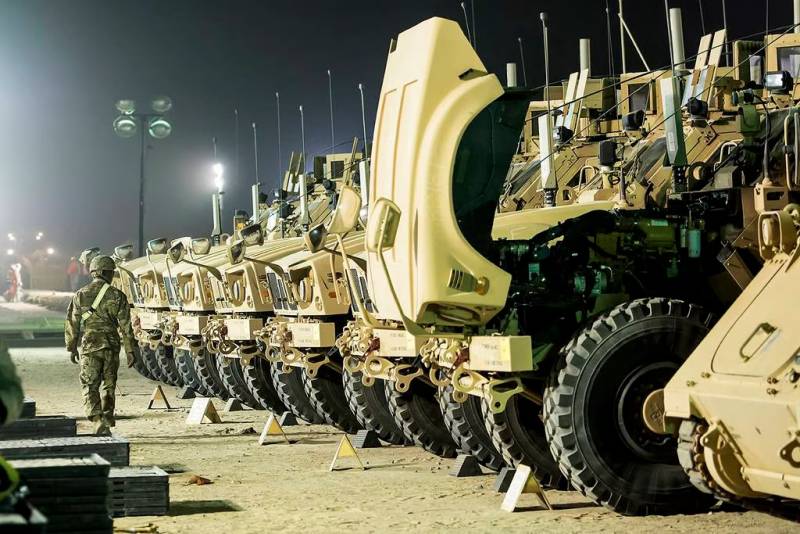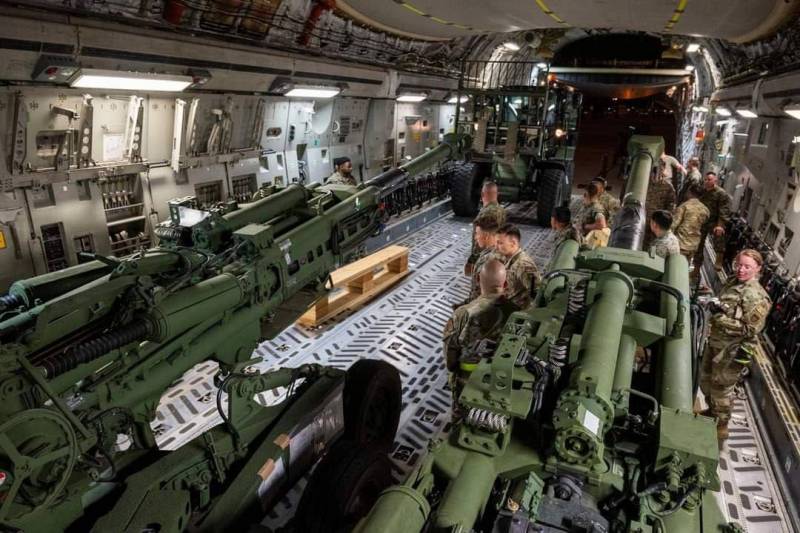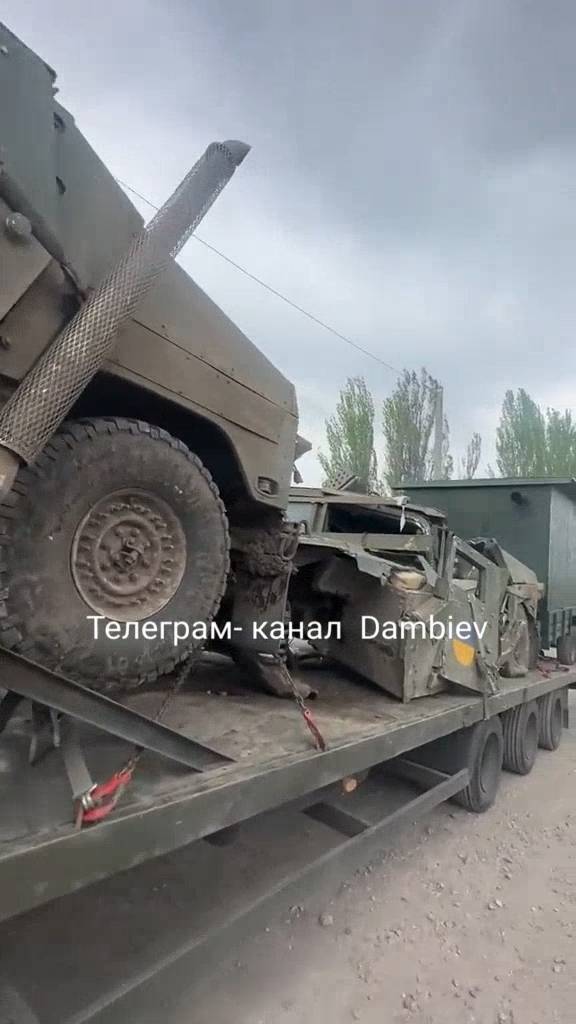Negligent owners: problems with the storage of US military equipment

JLTV armored cars based on APS in Kuwait, 2018. Photo by the US Department of Defense
Since last year, the United States has been actively helping the Kyiv regime with the supply of various weapons and equipment from its own armed forces. However, the search for transferable property ran into unexpected problems. Part weapons and equipment was in poor condition and was unusable. Additional repairs and restoration of technical readiness led to a loss of time and money.
According to the results of the check
In the first months of 2022, the Pentagon decided to start full-scale military-technical support for the Kyiv regime. It was planned to send to Ukraine various weapons and equipment taken from the warehouses of its own army. To do this, they clarified the current state of affairs and the state of their own arsenals, after which the preparation of the first aid packages began.
According to the plans of that time, a significant amount of weapons for Ukraine should have been taken at Army Prepositioned Stock (APS) type storage bases located abroad. These are large facilities for long-term storage of various materiel in case of a full-scale conflict. In the event of the outbreak of hostilities, it is the seven available APS that must ensure the supply of the troops with the necessary weapons, ammunition and other products.
As it now turns out, not all APS conscientiously performed their job of preserving and maintaining the entrusted materiel. Almost immediately after the start of the formation of assistance packages, certain problems appeared related to the improper work of the staff and other factors. Recently, these events have become public knowledge.
In order to monitor ongoing work, the Office of the Chief Inspector of the Department of Defense conducted several inspections at APS bases and drew conclusions. At the end of May, the department released a report on the problems identified and possible ways to solve them. In addition, some details of the inspections carried out were disclosed.

Howitzers M777 for transfer to the Kyiv regime. Photo by the US Department of Defense
It is reported that the 401st Field Support Battalion, which is responsible for maintaining the APS base in Kuwait, has “particularly distinguished itself”. He did not properly maintain the M777 howitzers and HMMWV vehicles, which required unscheduled repairs. Such work led to unforeseen expenses, and also had a negative impact on the timing of the transfer of equipment and weapons to the Kyiv regime.
Based on the results of the audit, the Office recommended that the Pentagon develop and implement a new procedure for maintaining materiel at APS bases and monitoring these processes. In addition, it is proposed to take a more careful approach to the choice of equipment and weapons for transfer to Ukraine - so that the preparation of equipment and other procedures do not get out of the established schedule.
Culprits and spending
The American edition of Defense News was not limited to the official press release and was able to get the full text of the report of the Office of the Inspector General. With reference to this document, it published various details of the current situation with the materiel.
It is reported that the 401st Support Battalion was not the only culprit in the situation at the base in Kuwait. In accordance with the existing state contract, part of the work with the products placed there is entrusted to a commercial contractor - the Amentum company from pcs. Virginia. It was she who was supposed to maintain the condition of howitzers and vehicles that did not pass the test.
Other structures also participated in the search, selection and examination of materiel for transfer to Ukraine. So, a mobile repair team was called to Kuwait from the Aniston storage base (Alabama), which was to determine the condition of the equipment and its readiness for shipment abroad.

An M777 howitzer in a war zone - moments before it was hit. Photo by the Ministry of Defense of the Russian Federation
The team identified a number of deficiencies and issues requiring urgent attention. On her own, she carried out part of the work on howitzers and restored them. At the same time, at the stage of the transfer of guns, new problems were revealed, which also had to be corrected. The situation was similar with cars - they had to be repaired on the spot and during transportation.
According to Defense News, the repairs required not only time, but also money. Thus, the repair of M777 howitzers in Kuwait by the repair team cost the Pentagon $114. The second stage of repairs, already during the transfer, cost $17,5. Work with vehicles at all stages of preparation and transfer required an additional $173,5. Doll.
According to Defense News, the support command, to which the 401st Battalion belongs, has already found an excuse. It believes that the cause of last year's problems is a lack of funding. In the current defense budget, more than $91 million is allocated for the operation of the APS base in Kuwait. However, less than $28 million is given for the maintenance of materiel, which is not enough to solve all tasks.
In addition, inspectors are reportedly making excessive demands on the commercial contractor. Management did not take into account Amentum's obligations under the existing contract and its existing competencies, which led to incorrect conclusions.
Problematic guns
It was planned to pick up six M777 howitzers from the APS base in Kuwait. In March 2022, a repair team from the Anniston base came to receive them. A commercial contractor provided one of the guns, purporting to meet operational requirements. However, the brigade found that the howitzer was not properly maintained and actually posed a danger to its own crew. Then problems were identified with other guns.

Broken Ukrainian cars HMMWV. Perhaps among them were cars from Kuwait. Photo Telegram / Dambiev
Four out of six howitzers had problems with locking the shutter: when fired, this could lead to a breakthrough of gases and the defeat of the calculation. In addition, contrary to instructions, the contractor filled the recoil devices of all implements with old, used hydraulic fluid. This could disrupt the operation of devices, incl. with risks to personnel.
In June, just before being shipped to Europe, the brakes caught fire while towing one of the M777 howitzers. According to one version, this happened due to the fact that the calculation did not turn off the parking brake. According to another, there was a brake fluid leak. After being delivered from Kuwait to Poland, the guns were again examined, and this time problems with trigger mechanisms were revealed, which required another stage of repair.
Army car service
According to Defense News, by August last year, the command ordered the 401st Battalion to prepare 29 M1167 HMMWV vehicles for shipment. Soon the battalion reported on the readiness of 28 vehicles. On August 24, an order was received to send this equipment, and at that moment only 3 units were ready for operation. technology.
According to the Office of the Inspector's report, the remaining vehicles had minor breakdowns that prevented full operation. There were fluid leaks, dead batteries, headlights not working, sensors broken, etc. Minor repairs were made - by removing the necessary parts from other machines. In this form, the Humvee was sent from Kuwait to Poland.
Already in Poland, a cracked tire unsuitable for use was found on one of the cars. Instead of a damaged wheel, a spare was put in, but he was also struck by "dry rot". Similar problems were expected with other machines. At the same time, the reports noted that not all arriving HMMWVs were equipped with spare wheels. To avoid further problems, cars for Ukraine were equipped with wheels taken from existing vehicles.

Broken and burnt Humvee. Photo Telegram / Dambiev
Save and restore
Thus, one of the key facilities of the US Army and its commercial contractor failed to cope with the assigned tasks. They were supposed to maintain an acceptable technical condition of the entrusted materiel, but the very first check showed that the required work was carried out inaccurately and without observing the regulations.
As part of a recent report, we are talking about only 6 problematic howitzers and 28 vehicles. However, the real scale of the problems may be greater. The 401st Battalion and its contractors are responsible for more guns and vehicles and other items, and it is likely that they are not better served. Accordingly, the average condition of the materiel based on the APS may be a cause for concern for the command.
It is clear what this situation can lead to. The base in Kuwait and other similar facilities are designed to provide the army in the event of an armed conflict. If there are observed problems, they will not be able to transfer equipment and weapons to the troops in a timely manner and in the required quantities. How this will affect the potential of the army is not difficult to understand.
However, last year's situation with howitzers and cars also shows that support units are able to solve emerging problems. Both in Kuwait and at the stage of transportation, they managed to identify and eliminate equipment problems. However, this led to a significant shift in delivery times, and also increased overall costs.
To what extent the Pentagon is ready to solve such problems and what costs it can put up with is a big question. At the same time, the current situation fundamentally does not suit the military department. In this regard, it is proposed to revise and improve the system for repairing and maintaining the condition of materiel at storage bases, as well as to make control and supervision more efficient. What such measures will be, and whether they will justify the hopes laid down, will become clear later.
Information